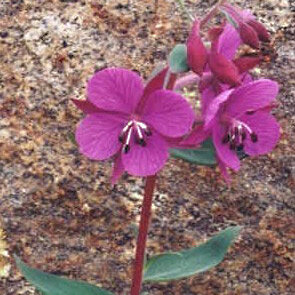Annual or perennial herbs, shrubs or (rarely, and not in Australia) trees. Leaves alternate, opposite or whorled, simple, entire, toothed or pinnatifid. Stipules minute or absent. Inflorescence usually spicate, or racemose, with or without bracts, or flowers solitary, axillary. Flowers usually hermaphrodite, often 4-or 5-merous, occasionally 2–7-merous, epigynous. Hypanthium often prolonged above ovary. Sepals valvate, often deciduous. Petals often conspicuous, occasionally absent. Stamens usually twice as many as sepals, usually in 2 whorls, 1 antisepalous, 1 antipetalous; anthers basifixed or versatile, longitudinally dehiscent; pollen grains with viscin threads on proximal surface. Ovary inferior, 1–7-locular; placentation axile or parietal; stigma capitate or lobed. Fruit a capsule, berry or nut. Seeds numerous, occasionally few or (not in Australia) 1, sometimes bearing a tuft of hairs; endosperm absent.
Herbs, sometimes shrubs, very rarely trees. Leaves alternate, opposite or rarely whorled, simple; petiole not inflated in middle. Stipules absent or small. Flowers solitary and axillary, sometimes aggregated into racemes or panicles, normally hermaphrodite, regular or rarely irregular. Sepals valvate, mostly 4, sometimes 5, rarely 2, 3, 6 or 7. Petals free, as many as sepals, contorted or imbricate, rarely absent. Stamens as many or twice as many as sepals, very rarely fewer. Ovary inferior, mostly 4-celled, rarely 1–7-celled. Style simple. Ovules axile, one to many per cell. Fruit a capsule, rarely a nut or a berry. Seeds without endosperm
Stamens usually twice as many as the sepals and in 2 sets, 1 opposite the sepals and 1 opposite the petals, or as many as the sepals, sometimes reduced in number to 2; anthers versatile but sometimes attached near the base, dehiscing longitudinally
Flowers actinomorphic or zygomorphic, hermaphrodite or rarely unisexual, 4–or 5–(rarely 2–, 3–, or 6–)merous, borne in the axils of usually reduced foliage leaves or in a more or less distinct inflorescence, usually a corymb or raceme
Herbs, shrubs, or rarely trees with alternate or opposite, rarely whorled, simple, entire, lobed or pinnatifid leaves; stipules minute or absent
Fruit a loculicidally or more rarely irregularly dehiscent capsule, sometimes indehiscent, or a berry, 1-many-seeded; placentation axile
Flowers solitary and axillary, sometimes aggregated into racemes, or panicles, normally hermaphrodite, regular or rarely irregular
Leaves alternate, opposite or rarely whorled, simple; petiole not inflated in middle
Petals free, as many as sepals, contorted or imbricate, rarely absent
Style single; stigma variously lobed, discoid, elongate, or capitate
Petals free (very rarely fused to the sepals), or sometimes absent
Stamens as many or twice as many as sepals, very rarely fewer
Sepals valvate, mostly 4, sometimes 5, rarely 2, 3, 6 or 7
Ovary inferior, mostly 4-celled, rarely 1–7-celled
Herbs, sometimes shrubs, very rarely trees
Seeds small, anatropous, lacking endosperm
Fruit a capsule, rarely a nut or a berry
Sepals free or very rarely connate
Ovules axile, one to many per cell
Floral tube present or absent
Stipules absent or small
Seeds without endosperm
Ovary inferior
Style simple

